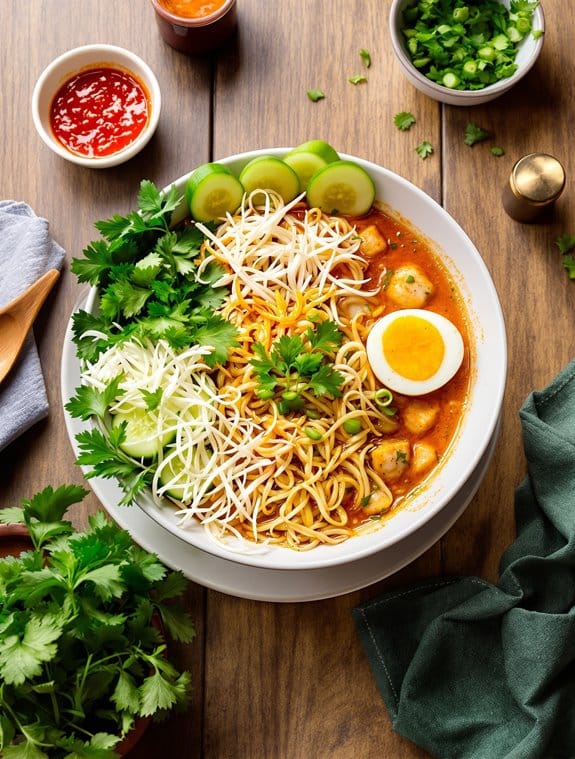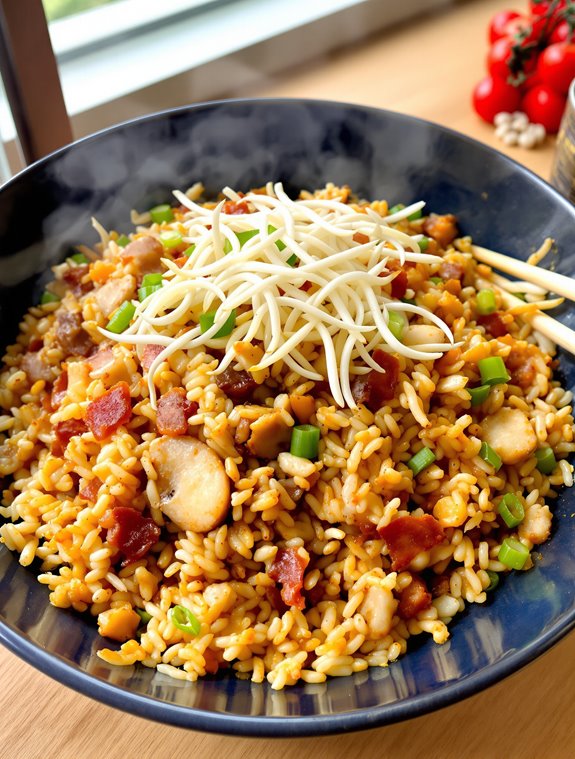Why You’ll Love this Aromatic Laksa
Frequently, I find myself craving a dish that truly transports me with its aroma and flavor, and this aromatic laksa recipe never disappoints. The complex blend of spices—coriander, lemongrass, garlic, shallots—creates layers of flavor that dance on your tongue. You can customize it with seafood, chicken, or tofu, making it perfect for any dietary preference.
What I love most? The way your kitchen fills with that unmistakable fragrance as the laksa paste sizzles in oil.
It’s comfort food with a kick, simultaneously warming and exciting. Trust me, once you master this Southeast Asian staple, you’ll find yourself reaching for these ingredients again and again.
What Ingredients are in Aromatic Laksa?
Creating an aromatic laksa is all about blending the perfect balance of spices, herbs, and ingredients to achieve that signature fragrant broth that’s both creamy and spicy.
The beauty of this Southeast Asian dish lies in its versatility—you can customize your protein options while keeping the aromatic base consistent. I’m always amazed at how such simple ingredients can create such a complex flavor profile when combined in just the right way.
- 1 kg seafood (shrimp, fishcakes, crabmeat, fish fillets) or tofu (or a combination)
- 2 tablespoons coriander seeds
- 2 large red chilies and 2 small green chilies
- 1/2 stalk lemongrass, chopped, plus 2 stalks for the broth
- 8 garlic segments
- 8 shallots
- Fresh ginger, turmeric, and galangal (about 1/2-1 inch each)
- 2 candlenuts
- 1 tablespoon shrimp paste
- 1 kg egg noodles or rice vermicelli
- 1 tablespoon sesame oil
- 1 cup coconut milk
- 1.5 liters chicken or seafood stock
- 3 fresh basil leaves
- Garnishes: bean sprouts, cilantro, spring onions, crispy onions, cucumber, hard-boiled eggs
When shopping for these ingredients, the fresh herbs and spices make all the difference in creating that authentic aromatic profile.
Can’t find fresh galangal or turmeric? Dried versions will work in a pinch, though the flavor won’t be quite as vibrant.
For vegetarians, simply omit the shrimp paste and use vegetable stock instead of chicken or seafood stock.
The beauty of laksa is its adaptability while maintaining that distinctive aromatic essence that makes it so utterly craveable.
How to Make this Aromatic Laksa

The foundation of a great laksa begins with a flavorful stock. Start by boiling your choice of protein—1 kg of seafood like shrimp or fish fillets, or tofu if you prefer a vegetarian option—to create a rich base. If using tofu, deep-fry it until golden and drain well. This stock will form the soul of your laksa, so don’t rush this step; let those flavors develop fully.
Next comes the all-important laksa paste, where the magic really happens. Combine 2 tablespoons of coriander seeds, 2 large red chilies, 2 small green chilies, 1/2 stalk of chopped lemongrass, 8 garlic segments, 8 shallots, and about 1/2 inch each of fresh ginger, turmeric, and galangal. Add 2 candlenuts and 1 tablespoon of shrimp paste, then grind everything into a smooth paste.
Traditional cooks swear by using a stone mortar and pestle for this step—working one ingredient at a time and adding pinches of salt to help break down tougher ingredients. Can’t be bothered with all that pounding? A food processor works too, though I find the hand-ground version releases more aromatic oils.
To finish your laksa, heat enough oil in a saucepan to cover the paste, then stir-fry it with 3 fresh basil leaves and 2 stalks of lemongrass (flattened and knotted) until the kitchen fills with their incredible fragrance. Add your protein, then pour in 1.5 liters of stock, bringing it to a gentle simmer over low heat.
Stir in 1 cup of coconut milk, which gives laksa its signature creamy richness, and continue to simmer without boiling. Meanwhile, cook 1 kg of egg noodles or rice vermicelli according to package directions, drain, and toss with 1 tablespoon of sesame oil.
To serve, divide the noodles among bowls, ladle the aromatic broth over top, and garnish with fresh bean sprouts, cilantro leaves, chopped spring onions, crispy fried onions, cucumber slices, and halved hard-boiled eggs. The contrast between the hot, spicy broth and the cool, crunchy garnishes? Absolutely divine.
Aromatic Laksa Substitutions and Variations
While authentic laksa relies on specific Southeast Asian ingredients, you don’t need to abandon your laksa dreams if you can’t find everything at your local store. I often substitute dried galangal for fresh, or even swap in ginger with a pinch of pepper for a similar warming effect.
No candlenuts? Macadamias work surprisingly well. For a vegetarian version, I use tofu and vegetable stock instead of seafood.
Sometimes I go rogue and add kale or bok choy for extra greens. The beauty of laksa is its adaptability—make it spicier, creamier, or heartier according to your mood.
What to Serve with Aromatic Laksa
Now that you’ve mastered the basics of laksa preparation, let’s talk about perfect pairings for this fragrant, spicy bowl of goodness.
I love serving mine with a side of crispy fried wontons or fresh spring rolls to add textural contrast. The recipe already suggests bean sprouts, cilantro, and crispy onions as garnishes—trust me, don’t skip these.
A cooling cucumber salad with rice vinegar dressing works wonders alongside the heat of laksa.
And for drinks? Nothing beats a cold Tiger beer or a sweet Thai iced tea to balance the spice. Simple, invigorating, perfect.
Final Thoughts
After mastering this aromatic laksa recipe, you’ll understand why it’s become a staple in my kitchen rotation.
The combination of fresh herbs, spicy chili, and creamy coconut milk creates a symphony of flavors that transports me straight to Southeast Asia every time.
I’ve found this dish perfect for impressing dinner guests or warming up on rainy days.
The beauty of laksa? It’s endlessly customizable. Prefer vegetarian? Swap in tofu. Can’t handle heat? Adjust those chilies.

Aromatic Laksa: Southeast Asian Comfort
Ingredients
Equipment
Method
- Begin by preparing your protein. If using seafood, boil it briefly to create a rich base. For tofu, deep-fry until golden and drain well.
- For the laksa paste, combine coriander seeds, red and green chilies, chopped lemongrass, garlic, shallots, fresh ginger, turmeric, galangal, candlenuts, and shrimp paste. Grind into a smooth paste using a food processor or traditional mortar and pestle.
- Heat enough oil in a saucepan to cover the paste. Add the laksa paste along with fresh basil leaves and the remaining lemongrass stalks (flattened and knotted).
- Stir-fry the paste until fragrant, then add your prepared protein.
- Pour in the stock and bring to a gentle simmer over low heat.
- Stir in the coconut milk and continue to simmer without boiling to maintain the creamy texture.
- Meanwhile, cook the noodles according to package directions, drain, and toss with sesame oil.
- To serve, divide the noodles among bowls, ladle the aromatic broth over top, and garnish with bean sprouts, cilantro leaves, chopped spring onions, crispy fried onions, cucumber slices, and halved hard-boiled eggs.



